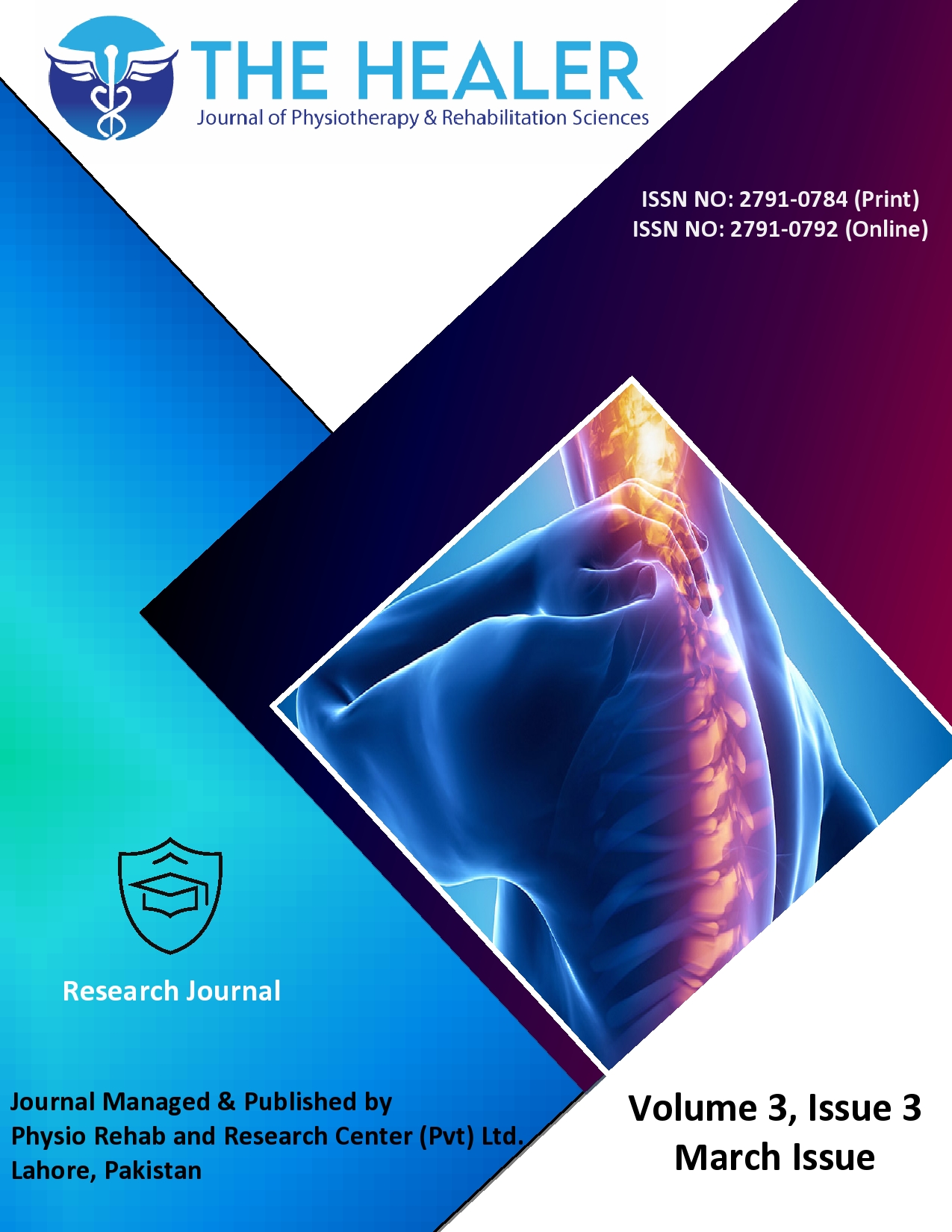Cardiorespiratory Fitness and Level of Perceived Stress in Exercising and Non-Exercising Physical Therapy Students: A Single-Centered Survey
Cardiorespiratory Fitness and Level of Percieved Stress
DOI:
https://doi.org/10.55735/hjprs.v3i3.133Keywords:
cardiorespiratory fitness, modified Harvard step test, perceived stress scaleAbstract
Background: Cardiorespiratory fitness is one of the basic components of physical fitness. It is considered a direct measure of the physiological status of the individual and it is a chief benchmark of physical well-being. There is a close association between physical fitness and the health outcomes of individuals. Objective: To assess cardiorespiratory fitness and perceived stress level and to measure the correlation between them in exercising and non-exercising physical therapy students. Methods: A descriptive cross-sectional study was conducted at Lahore Medical and Dental College for a duration of almost six months from April to October 2019. A total of 240 students from 1st to final year students were enrolled in the study using non-probability convenient sampling. The participants were categorized into two groups based on inclusion and exclusion criteria. Cardiorespiratory fitness was assessed by using the modified Harvard step test and the level of perceived stress was measured by the perceived stress scale questionnaire. Data analyses were carried out using SPSS 22 ad results were presented in the form of mean and standard deviation. Results: A significantly higher degree of cardiorespiratory fitness was found in Group A (exercising) compared to Group B (non-exercising) and a significantly lower level of perceived stress was found in Group A as compared to Group B (p-value≤0.05). Bivariate analysis indicates a moderate, negative connection between physical fitness index and perceived stress (p<0.001; r=-0.65). Conclusion: The current study concluded that the exercising group showed better cardiorespiratory fitness and lower perceived stress as compared to the non-exercising group. Cardiorespiratory fitness and perceived stress showed a highly significant correlation which is moderate in strength and inversely proportional. This means that as cardiorespiratory fitness increases, the level of perceived stress decreases.
References
Rai R, Chugh P, Negi M. A Study on cardiovascular fitness of sedentary college students. Int J of Sci Res 2015; 4(6): 109-12.
Cheng J-C, Chiu C-Y, Su T-J. Training and Evaluation of Human Cardiorespiratory Endurance Based on a Fuzzy Algorithm. International Journal of Environmental Research and Public Health 2019; 16: 2390.
Ruiz JR. Cardiorespiratory fitness and cardiovascular disease risk factors in children and adolescents: Biovetenskaper och näringslära/Biosciences and Nutrition; 2007.
Medicine ACoS. ACSM's guidelines for exercise testing and prescription: Lippincott Williams & Wilkins; 2013.
Williams PT. Physical fitness and activity as separate heart disease risk factors: a meta-analysis. Med Sci Sports Exerc 2001; 33(5): 754-61.
VanKim NA, Nelson TF. Vigorous physical activity, mental health, perceived stress, and socializing among college students. American Journal of Health Promotion 2013; 28(1): 7-15.
Aldana SG, Sutton LD, Jacobson BH, Quirk MG. Relationships between leisure time physical activity and perceived stress. Perceptual and Motor skills 1996; 82(1): 315-21.
Phillips AC. Perceived Stress. In: Gellman MD, Turner JR, eds. Encyclopedia of Behavioral Medicine. New York, NY: Springer New York; 2013: 1453-4.
Nabkasorn C, Miyai N, Sootmongkol A, et al. Effects of physical exercise on depression, neuroendocrine stress hormones and physiological fitness in adolescent females with depressive symptoms. European journal of public health 2006; 16(2): 179-84.
Salmon P. Effects of physical exercise on anxiety, depression, and sensitivity to stress: a unifying theory. Clinical psychology review 2001; 21(1): 33-61.
Meyers CR. A Study of the Reliability of the Harvard Step Test. Research Quarterly American Association for Health, Physical Education and Recreation 1969; 40(2): 423-.
Reis RS, Hino AAF, Añez CRR. Perceived stress scale: reliability and validity study in Brazil. J Health Psychol 2010; 15(1): 107-14.
Sharma P, Sharma R, Choudhary A, Vats H, Kataria J, Asif M. Assessment of level of physical fitness and level of mental stress in exercising and non-exercising physiotherapy students. Assessment 2018; 3(5).
Gerber M, Endes - Imhof K, Brand S, et al. In 6- to 8-year-old children, cardiorespiratory fitness moderates the relationship between severity of life events and health-related quality of life. Quality of
Life Research 2016; 26.
Tomruk M, gürpınar b, Özyürek S, KaradİBak D, ÇAkir Ö, Angin S. Relationship between physical activity and perceived stress in physiotherapists. JETR 2016; 3: 15-20.
Parmar D, Vishwasvaghela. Study of physical fitness index using modified harvard step test in relation with body mass index in physiotherapy students. International Journal of Recent Advances in Multidisciplinary Research (IJRAMR) 2015.
Pawaria S, Kalra S. Study on Cardio-Respiratory Fitness of Physiotherapy Students: A Cross-Sectional Study. International Journal of Yoga, Physiotherapy and Physical Education 2017; 2: 22-4.
Khodnapur JP, Dhanakshirur GB, Bagali S, Mullur LM, Aithala M. Status of Physical Fitness Index (PFI%) and anthropometric parameters in residential school children compared to nonresidential school children. JKIMSU 2012; 1: 137-41.
Bandyopdhyay B, Chattopadhyay H. Assessment of physical fitness of sedentary and physically active male college students by a modified Harvard step test. Ergonomics 1981; 24(1): 15-20.
Parmar D, Modh N. Study of physical fitness index using modified harvard step test in relation with gender in physiotherapy students. Int J Sci Res 2013; 4(1): 1215-7.
Adegoke BO, Akodu AK, Oyeyemi AL. Work-related musculoskeletal disorders among Nigerian physiotherapists. BMC musculoskeletal disorders 2008; 9(1): 112.
Smith D, Wei N, Ishitake T, Wang R-S. Musculoskeletal Disorders among Chinese Medical Students. The Kurume medical journal 2005; 52: 139-46.
Franklin B, McCullough P. Cardiorespiratory Fitness: An Independent and Additive Marker of Risk Stratification and Health Outcomes. Mayo Clinic proceedings Mayo Clinic 2009; 84: 776-9.
Atlantis E, Chow C-M, Kirby A, Singh MF. An effective exercise-based intervention for improving mental health and quality of life measures: a randomized controlled trial. Preventive medicine 2004; 39(2): 424-34.
Martins LCX, Lopes CS. Rank, job stress, psychological distress and physical activity among military personnel. BMC public health 2013; 13(1): 716.

Downloads
Published
How to Cite
License
Copyright (c) 2023 The Healer Journal of Physiotherapy and Rehabilitation Sciences

This work is licensed under a Creative Commons Attribution 4.0 International License.
CC BY












